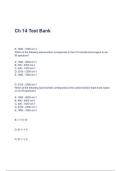Ch
14
Test
Bank
E.
1600
-
1850
cm-1
Which
of
the
following
wavenumber
corresponds
to
the
C=O
double
bond
region
on
an
IR
spectrum?
A.
1500
-
4000
cm-1
B.
400
-
4000
cm-1
C.
400
-
1500
cm-1
D.
2100
-
2300
cm-1
E.
1600
-
1850
cm-1
D.
2100
-
2300
cm-1
Which
of
the
following
wavenumber
corresponds
to
the
carbon/carbon
triple
bond
region
on
an
IR
spectrum?
A.
1500
-
4000
cm-1
B.
400
-
4000
cm-1
C.
400
-
1500
cm-1
D.
2100
-
2300
cm-1
E.
1600
-
1850
cm-1
B.
I
>
II
>
III
D.
III
>
I
>
II
D.
III
>
I
>
II D.
IV
C.
III
C.
III
A.
I
E.
IV
>
II
>
V
>
I
>
III
Compound
I
has
a
conjugated
double
bond
that
allows
for
more
single
bond
character
to
the
carbonyl
group.
This
results
in
absorption
of
the
carbonyl
group
at
a
lower
wavenumber .
for
compound
II
the
oxygen
atom
allows
for
additional
resonance
structures,
which
results
in
more
single
bond
character
for
the
carbonyl
group.
This
results
in
absorption
of
the
carbonyl
group
at
a
lower
wavenumber .
A.
I
C.
sharp,
absence
of
hydrogen
bonding
38.
Diluted
alcohols
show
a
_____absorption
around
3600
cm-1,
due
to
_____.
A.
sharp,
hydrogen
bonding
B.
broad,
hydrogen
bonding
C.
sharp,
absence
of
hydrogen
bonding
D.
broad,
absence
of
hydrogen
bonding B.
broad,
hydrogen
bonding
39.
Concentrated
alcohols
show
a
_____absorption
in
the
region
of
3200-3600
cm-1,
due
to
_____.
A.
sharp,
hydrogen
bonding
B.
broad,
hydrogen
bonding
C.
sharp,
polarity
D.
broad,
polarity
41.
Primary
amines
show
two
medium
absorption
bands
around
3400
cm-1,
due
to
_______.
A.
symmetric
stretching
B.
asymmetric
stretching
C.
both
symmetric
and
asymmetric
stretching
D.
hydrogen
bonding
C.
both
symmetric
and
asymmetric
stretching
aldehyde
For
each
of
the
following
IR
spectra
determine
if
it
is
consistent
with
the
structure
of
an
alcohol,
a
ketone,
an
aldehyde,
a
carboxylic
acid,
a
primary
amine
or
a
secondary
amine.
alcohol
For
each
of
the
following
IR
spectra
determine
if
it
is
consistent
with
the
structure
of
an
alcohol,
a
ketone,
an
aldehyde,
a
carboxylic
acid,
a
primary
amine
or
a
secondary
amine.
2º
amide




